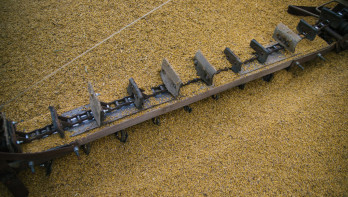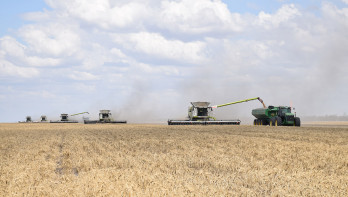Analysis Grains
Rain hinders autumn work in Europe
The stock market in Paris may have suggested otherwise, but for analysts it was a busy day. In the US, the new Crop Progress report was released and there was a surprise for wheat. The drought in the US is not without consequences, shall we say. In Europe, we are waiting for drier weather. This was further emphasized in the Mars Bulletin, which was also published yesterday. Russian grain exporters are not sticking to their own floor price, as shown in the latest Ikar listing. Meanwhile, Egypt is being squeezed but does not want to point the accusing finger at Russia.
The December contract for wheat on the Matif closed €0.25 higher at €217 per ton yesterday. On the CBoT, wheat took a hit in the last trading session and closed 1.8% lower at $5.58¾ per bushel. Corn also declined and closed 1.1% lower at $4.10¾ per bushel. Soybeans followed the trend in grains and also closed lower on the Chicago market. The November contract closed 1.4% lower at $9.74 per bushel.
Russia is still struggling to boost the wheat price. Ikar lowered the listing for Russian wheat by $2 to $232 per ton. This puts the price $8 below the minimum price proposed by the Russian Ministry of Agriculture and the Russian Union of Grain Exporters for October. There are no major changes in exports. According to SovEcon data, Russia exported 1.02 million tons of grain last week, of which 1 million tons were wheat. A week earlier, 1 million tons of wheat were also exported.
Egypt will receive 430,000 tons of wheat later than planned. Egyptian Supply Minister Sherif Farouk told Bloomberg. The wheat was supposed to be delivered in October with an extension until the first week of November. The delay, according to some analysts, highlights the challenges Egypt - one of the world's largest wheat importers - faces in building up sufficient stock. In Russia, there is a discussion among exporters about who will fill Egypt's large tenders. Egypt does not want to disclose from which countries the delayed wheat should come. Analysts more or less assume it is Russian suppliers.
Drought in the US
In the US, 80% of the planned winter wheat acreage has been sown, according to the new USDA Crop Progress report. Last year this week, 82% was sown, and the five-year average stands at 84%. 56% of the wheat is above ground, compared to 61% last year and the five-year average. This week, the first table on the condition of winter wheat was included in the Crop Progress report. This was a bit of a shock for some analysts. According to the USDA, 38% of the winter wheat is rated good or excellent, and 23% is rated poor or very poor. For comparison, the ten-year average for this week stands at 51% good or excellent and 14% poor or very poor. The moderate condition of winter wheat is not entirely unexpected, with 58% of the winter wheat experiencing some degree of drought.
The corn and soybean harvest in the US is well underway. Soybeans are 89% harvested according to the USDA, compared to 82% last season and 78% in the five-year average. Even more impressive is the lead in corn harvest. 81% of the corn has been harvested compared to 68% last season and 64% in the five-year average. Some rain is forecasted this week in the US, but growers are not worried. Most of the crops are in, and a little precipitation is welcome to replenish soil moisture.
Continued Wet Weather
In addition to the USDA, the JRC (the scientific bureau of the European Commission) also released the monthly Mars Bulletin yesterday. The maize yield in the EU is estimated at 6.66 tons per hectare in the new edition. Last month it was 6.85, and the five-year average stands at 7.35 tons per hectare. The expected yields for sunflowers and soybeans were also reduced. A wet period following the drought of last summer in southeastern Europe is affecting yields in these crops. Above-average wet conditions are a common theme in the October Mars Bulletin. In Western and Central Europe, the harvest of the remaining crops is delayed due to rainfall. Farmers are also forced to wait to sow winter cereals. Partly because priority is given to the harvest of forage and grain maize, sugar beets, and potatoes, and partly because there are only a limited number of workable days.

Jurphaas Lugtenburg
© DCA Market Intelligence. Op deze marktinformatie berust auteursrecht. Het is niet toegestaan de inhoud te vermenigvuldigen, distribueren, verspreiden of tegen vergoeding beschikbaar te stellen aan derden, in welke vorm dan ook, zonder de uitdrukkelijke, schriftelijke, toestemming van DCA Market Intelligence.



